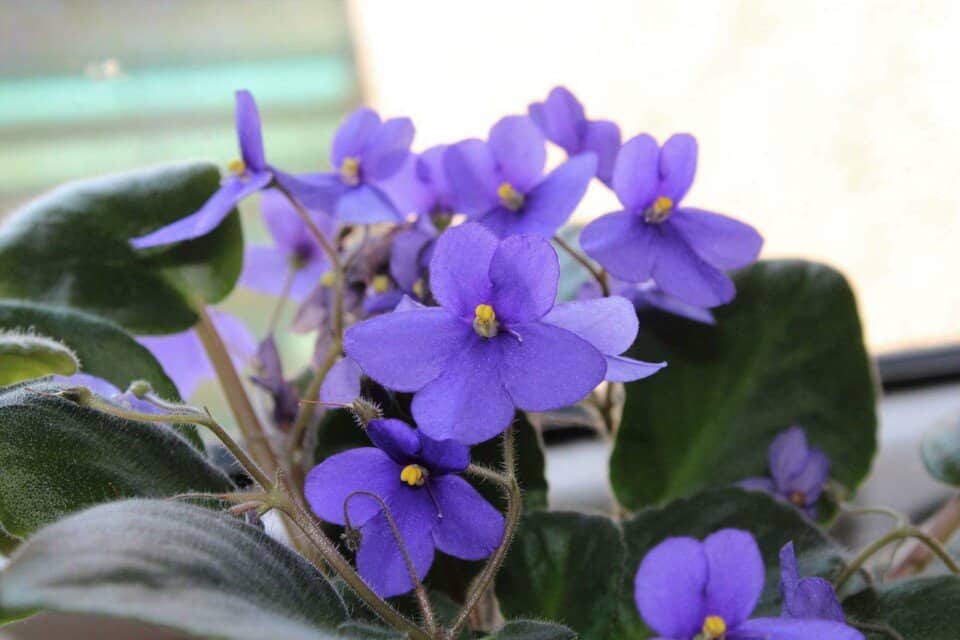Some links in the post are affiliate links and I get a commission from purchases made through some links found in the post.
If you are a flower person like me, you enjoy seeing a full bloom and do all in your power to ensure the flowers last longer.
Sometimes, I plant different cultivars of the same species to ensure that when one stops flowering, the other can take over.
It’s a bit much, but that is how much I enjoy gazing at flowers. So, imagine my joy upon learning that I could get a species that could bloom year-round with the proper care in tow.
What plant am I talking about? Why, the African violet, of course! This beautiful plant features impressive arrays of flowers that can beautify your home all year round.
But is it that easy to get them to bloom? And how long do the blooms last? This guide answers these and more questions:
How Often Do African Violets Bloom?
 Many people have heard that growing the African violet is not a cakewalk. But they also know that the results are well worth the effort.
Many people have heard that growing the African violet is not a cakewalk. But they also know that the results are well worth the effort.
So, what’s so special about the blooms on these plants?
Well, African violets can bloom nearly all year round and can live for up to 50 years! Some plants bloom for 10 months. All you need is to ensure that the plant has access to the right conditions.
So, you can enjoy new blooms each week and every coming month. How many plants can boast the same productivity? Any ideas?
Please note that the blooms come down to your specific plant. Sure, most African violets can bloom throughout the year. But some have lower productivity and may not be as showy.
While most of this depends on the plant’s genetics, you can always tweak the odds in your favor. I will detail this in a later section. So, if your African violet has been a letdown in the past, you can turn this around in a few moves.
How long will you enjoy the blooms? 50 years! That’s right – the African violet can live as long as half a century.
But to help them live this long, you must provide them with the right conditions and repot them often to allow their roots to establish an even stronger base.
How should you go about repotting them? You should wait until the plant has at least doubled the size of its current pot. And look out for signs like:
- Wilting, which indicates underwatering due to inadequate moisture uptake owing to root congestion,
- Roots showing up on the soil surface,
- Water welling up on the surface instead of getting absorbed by the soil,
- Roots sticking out of the pot’s drainage holes, and
- Stunted or no growth.
African violets do well when they are slightly rootbound. So, unless the plant exhibits negative changes, you can always wait a while longer and push it a few weeks until you are sure the plant cannot take it anymore. How should you repot the plant?
1) Only repot the plant when it is actively growing, i.e., the conditions should be ideal with temperatures at least 60 degrees Fahrenheit,
2) Moisten the soil to make removing the plant from the soil easier. Please wait at least an hour, then turn the pot to its side and start tapping on it to loosen the dirt.
If the dirt does not come off the surface, you can use a knife to loosen the bond between the dirt and the pot.
3) Remove the plant and lay it on its side. Then slice off the bottom 1/3 of the root ball – bet you didn’t see that coming.
But it works wonders in pushing your plant to be even more productive in its next environment. Then wash the plant with some running water, ensuring you do not damage the roots.
4) It’s now time to separate the plants so you can get more than one plant from the current one. Ideally, you should aim for two or three more plants by following the natural separations in the plant. Ensure each resultant plant has adequate roots.
Also, inspect the roots and cut off any sections that have suffered damage. Then treat the roots with a fungicide to ward off any fungal attacks.
5) You can now plant the parent plant and the other small plants in individual pots filled with good potting soil. Move up only one size when getting a new pot.
Else, you will encourage the plant to focus on filling the pot instead of developing foliage and producing more blooms.
If you keep doing this, you will live to enjoy many decades of beautiful blooms.
What Time of Year Do African Violets Bloom?
The answer is all year! But again, that depends. African violets bloom when they receive the proper care and experience temperatures above 60 degrees Fahrenheit.
It does even better at 70 degrees, but if you can observe the 60-degree minimum, all the better. Of course, maintaining such temperatures outdoors is not easy.
As such, people who grow their African violets outside may not enjoy the all-year blooming that other people do.
How about indoors? You have much more control over the humidity and temperature your African violet experiences. As such, you can get it to bloom all year.
So, there is no such thing as the time of year that your African violet should bloom. Instead, you should focus on whether the plant has access to the right growing conditions.
If it does, it will bloom – even if that means during summer, fall, winter, and spring!
How Long Do African Violets Bloom For?
There are two ways to answer this question. If you’re wondering how long your African violet will live, the answer is 50 years in the right conditions.
But if you are wondering how long each flower lasts on the plant, the period can be anything between two to three weeks.
Please note that healthy flowers last the longest, i.e., three weeks. But unhealthy flowers will not serve you this long and can even fall off within the first week.
It’s also important to remember that a flower can only be as healthy as its parent plant. So, the best way to ensure that you enjoy healthy blooms that last three weeks is by giving your plant a good start.
How Do You Get African Violets to Bloom Again?
Your African violet can bloom again and again. The trick lies in understanding the factors that prompt blooming and capitalizing on them to enhance the bloom production. Here’s what you can do to attain this goal:
1) Ensure your plant has adequate access to light

African violets rely on light to make enough food to sustain the growth of leaves and subsequent flowering. When they do not have enough light, they suffer stunted growth and may even suffer leaf drop.
Such an unhealthy plant cannot support its flowers, and it would either not produce flowers or would produce weak ones that would fall off before maturity.
Can you reverse this? Sure! The African violet likes bright and indirect light. You can achieve this by:
- Placing the plant near (not against) an east or west-facing window. Ensure you rotate the plant once a week to allow it to access enough light to make sufficient food.
- If the natural lighting is not sufficient, you can supplement the light with artificial lights placed about 12 inches from the top of the plant.
2) Increase the humidity around the plant
The African violet is not extremely picky about humidity, but it does best when it has at least moderate humidity.
If the plant starts showing signs of drooping coupled with browning along its edges, it may need more humidity. Test the humidity in your home and if it’s lower than 50%, seek ways to increase its levels. You can:
- Add more plants to the room so that as they transpire, they can release moisture to the space and amp the humidity,
- Introduce a humidifier to the space,
- Open the kitchen and bathroom doors to allow the moist air to flow through the house,
- Place a bowl of water near the plant so it can benefit from the evaporating water, and
- Position the plant pot over a tray filled with pebbles and water.
3) Feed your plant
Besides water and light, your plant also needs adequate access to nutrients to make sufficient food. When it does not have nutrients, it suffers stunted growth and can stop producing blooms altogether. How should you feed the plant?
- If you want your African violet to bloom for months in a row, you should feed it twice a month. It might seem like much, but it takes a lot of food production to sustain flowering.
- You should use fertilizers suited for African violets as these have the right balance of macro and micronutrients. Using feeds with too much nitrogen would only encourage the plant to produce foliage, and flowering would take a back seat.
4) Maintain its temperature range
I mentioned that the temperatures should not dip below 60 degrees Fahrenheit and that 70 degrees was the suitable range.
Why is this? These plants do not take too well to extreme temperatures as they are sensitive to heat and cold. To ensure they are happy, you should:
- Place them away from windows and doors, especially in the winter when cold drafts are commonplace,
- Position them away from cooling and heating vents, and
- Keep them away from the direct sun. While you should place the plants in light, the sun contact should never be direct.
5) Water the plant
What’s the other key component to photosynthesis? Water – without this, nutrient absorption cannot even take place. But how should you water the plant?
Ensure that the water does not touch the leaves, as this would only encourage pest infestation and fungal attacks. Instead, you should water the soil and moisten it rather than soaking it.
Overwatering the plant can drown its roots and cause yellowing, root damage, or even worse – death. Thus, you should only water the plant when the soil feels dry. And if you can, use warm water to water the soil.
Don’t forget to use well-draining soil that allows the excess water to drain.
Should You Cut Dead Flowers Off African Violet?
With some houseplants, it’s normal to feel like you want to hold on even to the dead blooms because the plants only bloom in the spring.
So, if you cut off the blooms, you have to wait another year before the plant flowers again. And in some plants, deadheading the blooms can hamper the production of more blooms.
But this is not something to worry about when it comes to the African violet. This plant blooms all year round and will keep doing so as long as it has the right growing conditions.
How then should you deal with the dead or damaged blooms? – Cutting them off!
Why should you get rid of them? The plant uses its energy to heal any damaged parts to strengthen its immune system.
So, it directs much-needed food to these dying and damaged blooms, taking away from vital processes like producing new and healthy flowers.
By cutting off the damaged plant parts, you refocus the plant’s energy on what’s important – more bloom production.
And here’s how you can deal with these blooms:
- Inspect the plant and seek out all the blooms that appear unhealthy or are dead.
- Get hold of the blooms, and, using a pair of scissors or a knife, cut them off in one swipe. You should only use a sterile and sharp tool to ensure you do not injure the plant – this would create an entryway through which pests and other disease-causing organisms would attack the plant. If you cut off any diseased blooms, sterilize the cutting tool before using it on another plant section. Else, you will only spread the disease.
- Assess the state of the plant every week to check if there are more dying or damaged blooms. Cut them off if you come across any more such parts.
As you keep doing this, the plant will only grow stronger, and you will enjoy blooms for more extended periods.
Do African Violets Stop Blooming & Why?
 Your plant should keep blooming even in its old age. But if this does not happen, you should consider if you are meeting the plant’s basic care requirements.
Your plant should keep blooming even in its old age. But if this does not happen, you should consider if you are meeting the plant’s basic care requirements.
Is it getting enough water? How about light and nutrients? If a plant stops getting what it needs, it will stop blooming so it can reserve its energy to grow stronger.
Final Thoughts
Very few plants can bloom as well and as long as the African violet.
So, if you are lucky to have one in your home, following the care instructions outlined in this guide will help you get the most out of it for decades. Happy Gardening!

